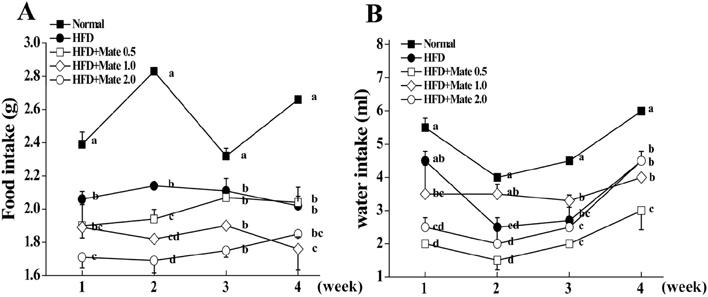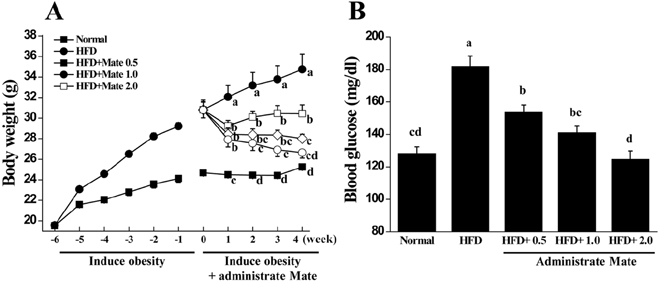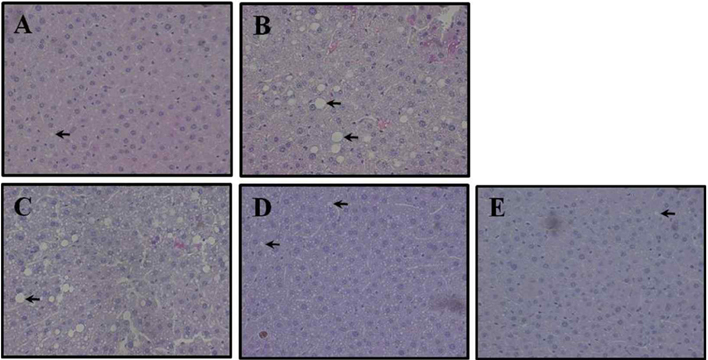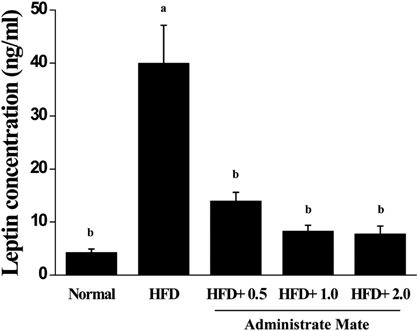Lab Anim Res.
2012 Mar;28(1):23-29.
Anti-obesity and anti-diabetic effects of Yerba Mate (Ilex paraguariensis) in C57BL/6J mice fed a high-fat diet
- Affiliations
-
- 1Huvet Co. Ltd, Iksan, Korea. dvmoh@hanmail.net
- 2GS E&C, Seoul, Korea.
- 3Department of pharmaceutical Engineering, Konyang University, Nonsan, Korea.
- 4Clinical Trial Center for Functional Foods, Chonbuk National University Hospital, Jeonju, Korea.
- 5Center for Animal Resources Development, Wonkwang University, Iksan, Korea. kimoj@wku.ac.kr
Abstract
- Yerba Mate, derived from the leaves of the tree, Ilex paraguariensis, is widely-used as a tea or as an ingredient in formulated foods. The aim of the present study was to evaluate the effects of Yerba Mate extract on weight loss, obesity-related biochemical parameters, and diabetes in high-fat diet-fed mice. To this end, by using in vivo animal models of dietary-induced obesity, we have made the interesting observations that Yerba Mate has the ability to decrease the differentiation of pre-adipocytes and to reduce the accumulation of lipids in adipocytes, both of which contribute to a lower growth rate of adipose tissue, lower body weight gain, and obesity. Our data from in vivo studies revealed that Yerba Mate treatment affects food intake, resulting in higher energy expenditure, likely as a result of higher basal metabolism in Yerba Mate-treated mice. Furthermore, in vivo effects of Yerba Mate on lipid metabolism included reductions in serum cholesterol, serum triglycerides, and glucose concentrations in mice that were fed a high fat diet. In conclusion, Yerba Mate can potentially be used to treat obesity and diabetes.
Keyword
MeSH Terms
Figure
Reference
-
1. Filip R, Lopez P, Giberti G, Coussio J, Ferraro G. Phenolic compounds in seven South American Ilex species. Fitoterapia. 2001. 72(7):774–778.2. Athayde ML, Coelho GC, Schenkel EP. Caffeine and theobromine in epicuticular wax of Ilex paraguariensis A. St.-Hil. Phytochemistry. 2000. 55(7):853–857.3. Rosna F, Silvina b, Lotito MS, Graciela F, Ceasar G. Fraga D. Antioxidant activity of Ilex paraguariensis and related species. Nutr Res. 2000. 20(10):1437–1446.4. Schinella GR, Troiani G, Dávila V, de Buschiazzo PM, Tournier HA. Antioxidant effects of an aqueous extract of Ilex paraguariensis. Biochem Biophys Res Commun. 2000. 269(2):357–360.5. Michael N, Cillford , Jose R, Ramirez M. Chorogeic acids and purine alkaloids contents of mate (Ilex paraguarinesis) leaf and beverage. Food Chemistry. 1990. 35(1):13–21.6. Pomilio AB, Trajtemberg S, Vitale AA. High-performance capillary electrophoresis analysis of mate infusions prepared from stems and leaves of Ilex paraguariensis using automated micellar electrokinetic capillary chromatography. Phytochem Anal. 2002. 13(4):235–241.7. Filip R, Sebastian T, Ferraro G, Anesini C. Effect of Ilex extracts and isolated compounds on peroxidase secretion of rat submandibuulary glands. Food Chem Toxicol. 2007. 45(4):649–655.8. Zaporozhets OA, Krushynska OA, Lipkovska NA, Barvinchenko VN. A new test method for the evaluation of total antioxidant activity of herbal products. J Agric Food Chem. 2004. 52(1):21–25.9. Kraemer KH, Taketa AT, Schenkel EP, Gosmann G, Guillaume D. Matesaponin 5, a highly polar saponin from Ilex paraguariensis. Phytochemistry. 1996. 42(4):1119–1122.10. Gosmann G, Guillaume D, Taketa AT, Schenkel EP. Triterpenoid saponins from Ilex paraguariensis. J Nat Prod. 1995. 58(3):438–441.11. Miranda DD, Arçari DP, Pedrazzoli J Jr, Carvalho Pde O, Cerutti SM, Bastos DH, Ribeiro ML. Protective effects of mate tea (Ilex paraguariensis) on H2O2-induced DNA damage and DNA repair in mice. Mutagenesis. 2008. 23(4):261–265.12. Andallu B, Varadacharyulu NCH. Antioxidant role of mulberry (Morus indica L. cv. Anantha) leaves in streptozotocin-diabetic rats. Clin Chim Acta. 2003. 338(1-2):3–10.13. Chua S, Leibel RL. Obesity genes: molecular and metabolic mechanisms. Diabetes Rev. 1997. 5(1):2–7.14. Mosimann AL, Wilhelm-Filho D, da Silva EL. Aqueous extract of Ilex paraguariensis attenuates the progression of atherosclerosis in cholesterol-fed rabbits. Biofactors. 2006. 26(1):59–70.15. Andersen T, Fogh J. Weight loss and delayed gastric emptying following a South American herbal preparation in overweight patients. J Hum Nutr Diet. 2001. 14(3):243–250.16. Pittler MH, Ernst E. Dietary supplements for body-weight reduction: a systematic review. Am J Clin Nutr. 2004. 79(4):529–536.17. Opala T, Rzymski P, Pischel I, Wilczak M, Wozniak J. Efficacy of 12 weeks supplementation of a botanical extract-based weight loss formula on body weight, body composition and blood chemistry in healthy, overweight subjects--a randomised double-blind placebo-controlled clinical trial. Eur J Med Res. 2006. 11(8):343–350.18. Berg AH, Scherer PE. Adipose tissue, inflammation, and cardiovascular disease. Circ Res. 2005. 96(9):939–949.19. Haslam DW, James WP. Obesity. Lancet. 2005. 366(9492):1197–1209.20. Bullo M, Casas-Agustench P, Amigo-Correig P, Aranceta J, Salas-Salvado J. Inflammation, obesity and comorbidities: the role of diet. Public Health Nutr. 2007. 10(10A):1164–1172.21. Lee HA, Hong S, Chung Y, Kim O. Sensitive and specific identification by polymerase chain reaction of Eimeria tenella and Eimeria maxima, important protozoan pathogens in laboratory avian facilities. Lab Anim Res. 2011. 27(3):255–258.22. Saldana MD, Mohamed RS, Baer MG, Mazzafera P. Extraction of purine alkaloids from maté (Ilex paraguariensis) using supercritical CO(2). J Agric Food Chem. 1999. 47(9):3804–3808.23. Heck CI, de Mejia EG. Yerba Mate Tea (Ilex paraguariensis): a comprehensive review on chemistry, health implications, and technological considerations. J Food Sci. 2007. 72(9):R138–R151.24. Bastos DHM, De Oliveira DM, Matsumoto RLT, Carvalho PO, Ribeiro ML. Yerba mate: pharmacological properties, research and biotechnology. Med Aromat Plant Sci Biotechnol. 2007. 1(1):37–46.25. Bracesco N, Sanchez AG, Contreras V, Menini T, Gugliucci A. Recent advances on Ilex paraguariensis research: minireview. J Ethnopharmacol. 2011. 136(3):378–384.26. Pittler MH, Schmidt K, Ernst E. Adverse events of herbal food supplements for body weight reduction: systematic review. Obes Rev. 2005. 6(2):93–111.27. Hemmerle H, Burger HJ, Below P, Schubert G, Rippel R, Schindler PW, Paulus E, Herling AW. Chlorogenic acid and synthetic chlorogenic acid derivatives: novel inhibitors of hepatic glucose-6-phosphate translocase. J Med Chem. 1997. 40(2):137–145.28. Nardini M, D'Aquino M, Tomassi G, Gentili V, Di Felice M, Scaccini C. Inhibition of human low-density lipoprotein oxidation by caffeic acid and other hydroxycinnamic acid derivatives. Free Radic Biol Med. 1995. 19(5):541–552.29. Pang J, Choi Y, Park T. Ilex paraguariensis extract ameliorates obesity induced by high-fat diet: potential role of AMPK in the visceral adipose tissue. Arch Biochem Biophys. 2008. 476(2):178–185.30. Rodriguez de Sotillo DV, Hadley M. Chlorogenic acid modifies plasma and liver concentrations of: cholesterol, triacylglycerol, and minerals in (fa/fa) Zucker rats. J Nutr Biochem. 2002. 13(12):717–726.31. Han LK, Zheng YN, Xu BJ, Okuda H, Kimura Y. Saponins from platycodi radix ameliorate high fat diet-induced obesity in mice. J Nutr. 2002. 132(8):2241–2245.32. Shimomura I, Hammer RE, Ikemoto S, Brown MS, Goldstein JL. Leptin reverses insulin resistance and diabetes mellitus in mice with congenital lipodystrophy. Nature. 1999. 401(6748):73–76.
- Full Text Links
- Actions
-
Cited
- CITED
-
- Close
- Share
- Similar articles
-
- Anti-obesity and LDL-cholesterol lowering effects of silkworm hemolymph in C57BL/6N mice fed high fat diet
- Anti-inflammatory and anti-diabetic effects of brown seaweeds in high-fat diet-induced obese mice
- Effects of fermented blueberry liquid in high-fat diet-induced obese C57BL/6J mice
- Anti-obesity effect of Ramulus mori extracts and stilbenes in high fat dietfed C57BL/6J mouse
- The protective effects of Aster yomena (Kitam.) Honda on high-fat diet-induced obese C57BL/6J mice








